Painter I Love: Pablo Picasso
The stunning now show, ‘Masterpieces from the Musee Natiional Picasso, Paris’ is a once-in-a-lifetime chance to come face to face with some of the most important and exciting paintings of the twentieth century. I attended a preview recently.
It’s a jaw-dropping show. Overwhelming.
I could have gazed for hours at the tenderly loving brushstrokes of pale mauve paint on ‘La Lecture’. And in the same romantic and sensual painting there's a pale blue shadowing of brushstrokes outlined with black that stopped me in my tracks.
I pondered the compositions, the dramatic modernity of works from the early twentieth century, and the mastery of expression, the originality, and the daring control.
I was entranced by the movement of color, and his use of juxtaposition and counterpoint. Frissons of delight!
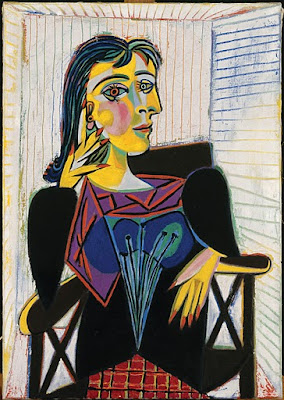 |
| Pablo Picasso Portrait of Dora Maar, 1937 Oil on canvas Musée National Picasso, Paris |
The superb new exhibit of Picasso’s 150 finest paintings, prints, sculptures and drawings at the de Young Museum in San Francisco, offers the crème de la crème and masterworks of Pablo Picasso’s eight-decade art career. (Through October 9.)
These are the paintings Picasso (1881-1973) kept for himself. He wanted to control his legacy. He hoarded his finest paintings. The works are now the jewels of the Picasso Museum in Paris.
And while I’ve seen quie a few of the iconic paintings in museum exhibits over the years, this new show is startlingly comprehensive, elegant, and magisterially powerful.
The Picasso Museum in the Marais in Paris is closed for renovation; two shows will be on view in San Francisco. A second Picasso exhibit follows the current one.
This summer is a feast for art lovers, a shot through the heart of pure creativity.
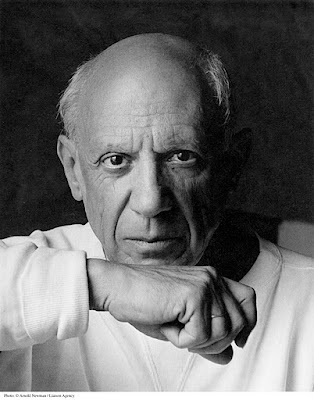 |
| Portrait of artist Pablo Picasso June 2, 1954 in Vallauris, France. © Arnold Newman/Get |
Ranging from informal sketchbooks to finished masterpieces, this unique collection of “Picasso’s Picassos” provides significant proof of the artist’s assertion that “I am the greatest collector of Picassos in the world.”
At the preview of the show, I walked in an exalted state from one painting to the next. My teeth tingled. Some moments I had to step back, in awe of a painting. Sometimes I had to look away. It’s one great painting after another.
Best of all, this show presents the paintings in a very straightforward style. It’s kind of chronological, but the paintings are given full attention, without a lot of overblown graphics, explanation, or biography. No obvious themes are spelled out, and no geography and personalities and strife and mayhem that are often such a distraction in blockbuster art shows today.
I loved the simplicity and directness of the presentation.
“This is how the director of the Picasso Museum wanted it—with no embellishment or biographical complication,” I was told by John Buchanan Jr., director of the Fine Arts Museums of San Francisco. ‘The paintings are the key element, not the parade of his life or any thematic distractions.”
“This is how the director of the Picasso Museum wanted it—with no embellishment or biographical complication,” I was told by John Buchanan Jr., director of the Fine Arts Museums of San Francisco. ‘The paintings are the key element, not the parade of his life or any thematic distractions.”
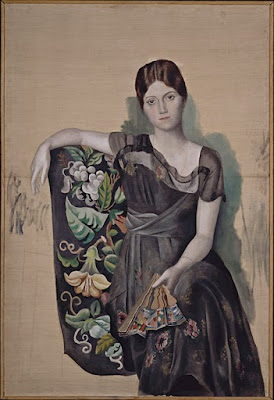 |
| Pablo Picasso Portrait d’Olga dans un fauteuil (Portrait of Olga in an Armchair) Oil on canvas. 1918 Musée National Picasso, Paris |
The exhibition is comprised of works from every phase of Picasso’s career.
“We’re showing masterpieces from his Blue, Rose, Expressionist, Cubist, Neoclassical and Surrealist periods,” continued Buchanan. ‘You can understand his career over seventy years.”
 |
| Pablo Picasso Le Baiser (The Kiss) Oil on canvas. 1969 Musée National Picasso, Paris |
 |
| Pablo Picasso La Célestine (La Femma à la taie) (Celestina [The Woman with One-Eye]) Oil on canvas. 1904 Musée National Picasso, Paris |
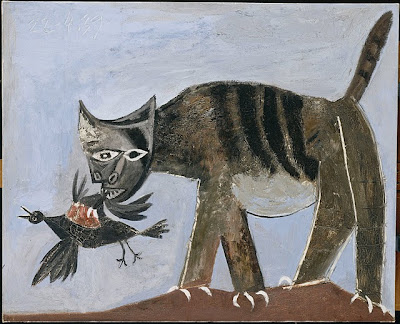 |
| Pablo Picasso Chat saisissant un oiseau (Cat Catching a Bird) Oil on canvas. 1939 Musée National Picasso, Paris |
Among my favorites: portraits of women in his life, who get his full attention on each canvas.
There’s wife Olga Khokhlova, realistically and with grace and classical artistry, depicted in Portrait of Olga in an Armchair (1918). It’s a lovely, poetic and arresting opening for the show.
Marie-Thérèse Walter, whose relationship with Picasso began when she was 17, is portrayed in voluptuous curves, pastel colors and soft sinuous volumes in Reclining Nude (1932).
On plinths are a series of five bronze busts created in 1931 that range from recognizable representations to nearly abstract. It’s a glorious period of his life, and to stand before the Reclining Nude portrait, is to see Picasso’s master of color, line, composition, emotional engagement and a captivating moment.
Dora Maar is represented in works characterized by hard-edged, jagged lines, angular forms and acidic color's such as Portrait of Dora Maar (1937).
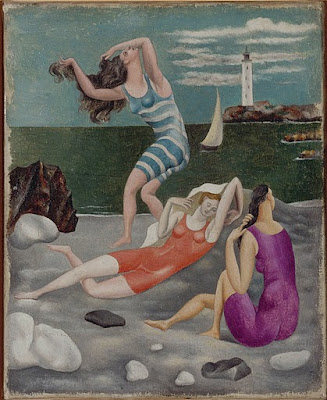 |
| Pablo Picasso Les Baigneuses (The Bathers) Oil on canvas. 1918 Musée National Picasso, Paris |
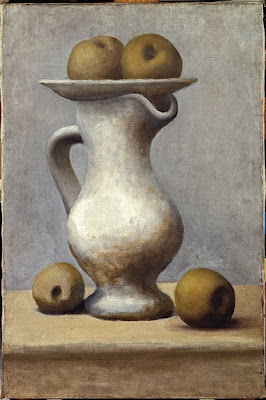 |
| Pablo Picasso Nature morte au pichet et aux pommes (Still Life with Pitcher and Apples) Oil on canvas. 1919 Musée National Picasso, Paris |
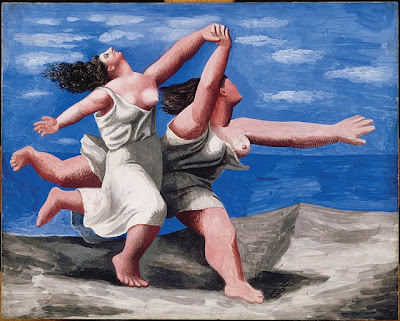 |
| Pablo Picasso Deux femmes courant sur la plage (La Course) Two Women Running on the Beach (The Race) Goache on plywood. 1922 Musée National Picasso, Paris |
These works present eloquent testimony that Picasso, constantly experimenting and leaping forward, transformed the definition of art.
Be sure to click here to read my feature on 'Chasing Picasso' and view his Chateau de Vauvenargues that I visited in Provence. Insight!
“The exhibition Picasso: Masterpieces from the Musée National Picasso, Paris lifts the curtain on the first act of our partnership between the Musée Picasso and the Fine Arts Museums of San Francisco,” says Anne Baldassari, general commissioner and president of the Musée National Picasso.
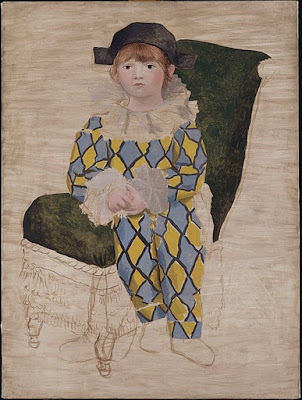 |
| Pablo Picasso Paul en Arlequin (Paul as Harlequin) Oil on canvas. 1924 Musée National Picasso, Paris |
The Musée National Picasso’s collection preserves the highly personal works that Pablo Picasso loved to have around him as he forged ahead with new canvases.
While I doubt that Picasso stopped for a moment and said ‘now I’m inventing Cubist’ or ‘now I’m in my Rose period’ or ‘time for surrealistic paintings now’ (that is for academics to formalize and expound on and intellectualize), the show featuring the various media in which he worked, this, and offers a survey of painting styles, subjects, periods and infatuations.
 |
| Pablo Picasso La Chevre (The Goat) Bronze. 1950 Musée National Picasso, Paris |
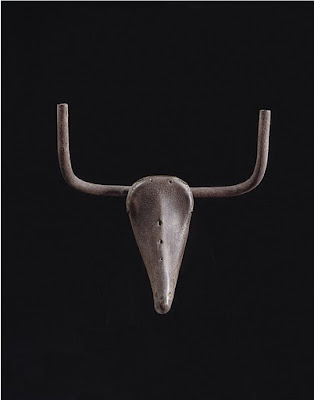 |
| Pablo Picasso Tete de Taureau (Bull's Head) Bicycle saddle and handlebars Musée National Picasso, Paris |
Included in the far-ranging exhibit:
One of his earliest Paris works—The Death of Casagemas (1901)
The Blue period—La Célestine (1904)
The Rose period—The Two Brothers (1906)
African-inspired proto-Cubist works were studies for Les Demoiselles d’Avignon (1907) and Three Figures Under a Tree (1907)
Analytic Cubism—Man with a Guitar (1911)
Synthetic Cubism—Violin (1915)
The Neoclassic period—Two Women Running on the Beach (1922)
Surrealism—The Kiss (1925)
The war years—The Weeping Woman (1937), and the sculptures Bull’s Head (1942) and Death’s Head (1943)
Work from his ultra-dynamic and bold late period including the self-portrait The Matador (1970)
 |
| Pablo Picasso L’Acrobate (The Acrobat) Oil on canvas. 1930 Musée National Picasso, Paris |
“I haven’t got a style,” Picasso claimed, but over the course of his long and prolific career, he created revolutionary works that laid the foundations of modern art.
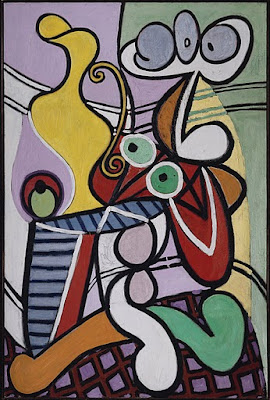 |
| Pablo Picasso Grand Nature morte au guéridon (Large Still Life with a Pedestal Table) Oil on canvas. 1931 Musée National Picasso, Paris |
The Musée National Picasso The Musée National Picasso, which opened in 1985 in the elegant 17th-century Hotel Sale in Paris, is the repository for nearly 3,600 works from the artist’s personal collection that passed to the French government (in lieu of taxes) following his death in 1973.
As the collection is so vast, only a small collection of works of art is on display at any point. For that reason, the de Young exhibit is particularly thrilling and rewarding. Many of the paintings currently at the de Young are not permanently on the walls of the Hotel Sale.
Catalogue An excellent illustrated catalogue of the exhibition Picasso: Masterpieces From the Musée National Picasso, Paris, co-published with Flammarion/Skira is available through the museum store. This makes a fine informational overload combined with the excellent catalogue from the 'Steins' collection show at SFMOMA.
 |
| The de Young Museum, San Francisco |
The de Young Museum The de Young, designed by Herzog & de Meuron and located in Golden Gate Park, is the nation’s fourth most visited art museum. It showcases American art from the seventeenth through the twenty-first centuries, international textile arts and costumes, and art from the Americas, the Pacific, and Africa.
Golden Gate Park, 50 Hagiwara Tea Garden Drive, San Francisco, CA 94118
Tuesday to Sunday, 9:30 am – 5:15 pm
Friday, 9:30 am – 8:45 pm
Closed Monday
deyoung.famsf.org
415.750.3600
CREDITS:
Friday, 9:30 am – 8:45 pm
Closed Monday
deyoung.famsf.org
415.750.3600
CREDITS:
All photographs courtesy Musee National Picasso, used with permission.


10 comments:
Thank you for this great review of the Picasso show. I've just put it on my calendar as a must see. Paul en Arlequin, seen alone, would be sufficient motivation to make the trip. Mary
Diane! you certainly made me want to take a peak at this. Hopefully a trip to San Fran is on my schedule. xxpeggybraswelldesign.com
You are the Mistress of great culture! Thank you so much for this post! What a wonderful way to start my morning! I am definitely making a trip to San Fran for this show!
Have a wonderful day!
Regards!
Jamie Herzlinger
Dear Mary and Peggy-
Thank you for your message.
Just to re-encounter Picasso...far from the hoopla and fan-fa-ra is a wonderful thing.
It is astonishing to see an artist's more than 60 year career encapsulated in this exhibit.
I am so impressed. It's presented in a lowkey manner, so the paintings come at you full force.
I could not have been more thrilled.
happy days DIANE
Picasso continues to be a constant fascination for me. His legacy of vision cannot be denied. Perfect post as usual.
Hi Carl-
Thank you for your enthusiasm.
We have lived with Picasso our whole lives...and yet this show is fresh and powerful. I felt that in some ways I was seeing his body of work for the first time. That is very exciting.
cheers--lovely to hear from you, DIANE
Dear Friends-
My dear friend Darra Baker left the most wonderful comment on Facebook:
"My kids and I went wild for his three-room retrospective at The Met in NYC last summer...so much so, in fact, we went two days in a row! Picasso posters from that exhibit hang proudly in their rooms...I would love to take a road trip up to SF with them, to see this. Thank you, as always, Diane, for bringing THE BEST to our attention"
Thank you, Darra. I can just imagine you speeding up Hwy 5 through the central valley...and heading straight to Golden Gate Park and the museum.Picasso awaits you.
cheers, as always, DIANE
Many underestimate the differences in seeing a print reproduction verses an original, and that is especially true with Picasso. Hopefully, a great number will be able to see these remarkable shows.
Fantastic post. We just did a post on how style evolves, and contrasted Picasso's First Communion of 1896 with the Dora Maar painting of 1941. I agree with you and the Devoted Classicist that seeing the originals in-person makes all the difference.
Oh Diane!! another tour de force!! And I had never read "Chasing Picasso" so, not one, but two!!
I am going to get to San Francisco for sure to see this once-in a lifetime exhibit!
thank you so much for those posts! Indescribable!
What a gift you give to all of us!!
Post a Comment